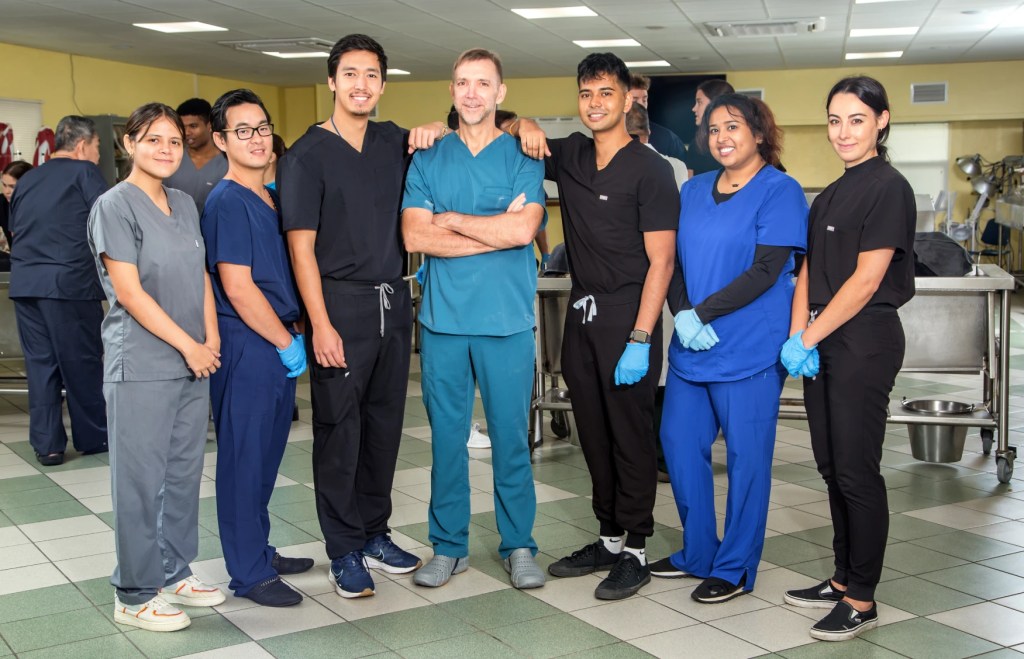
Questions?
Please contact us at info@saba.edu for more information.
Get to know Saba University School of Medicine at an event!

Degree Awarded: Master’s of Science in Biological Sciences
Program Length: 8-months (2 Semesters)
Semester 1: 14 Credits
Semester 2: 17 Credits
Total: 31 Credits
4 Credits
The course Principals of Medicine consists of two integrated components: advanced learning methods and medical terminology. Advanced learning methods help students preparing to enter medical school develop the study, learning, and test-taking skills they need to successfully deal with the volume and complexity of information involved in the curriculum. Medical terminology prepares pre-medical students for the complex language of medicine. Students will become familiar with the vocabulary for accurately describing the human body and associated components, conditions, and processes in a scientific manner. This course will also help students understand unfamiliar medical terms and appreciate their clinical applications.
4 Credits
The course Organic Chemistry will provide students the opportunity to learn the nature of carbon in organic compounds. It presents general principles of organic chemistry related to structure, stereochemistry, nomenclature, synthesis, uses and reactions of alcohols, ethers and aliphatic hydrocarbons; alkanes, alkynes, alkenes, cycloalkanes. Furthermore, this course relates the basic concepts of Organic Chemistry to structure and function of biological molecules, enzyme structure, function and regulation, the biochemical pathways of intermediary metabolism and their regulation in normal and aberrant states.
3 Credits
The course Organismal Biology provides students with a basic understanding of the diversity as evidenced in myriad biological systems. Concepts related to the diversity of life will be introduced. Students will also learn about phylogenetics as well as microbial, plant and animal structure and function.
3 Credits
The course Math & Physics for Biological Sciences consists largely of precalculus topics, but also includes a substantial treatment of probability. The “precalculus” topics include relations, functions, coordinate systems, graphing, polynomials, trigonometric functions, algebra and logarithmic and exponential functions. Probability topics include random experiments and random variables, algebra of sets, methods of enumeration, sampling, conditional probability, and distributions of discrete types. In addition, this course includes base and derived units, vectors and scalars, kinematics in one and two dimensions, dynamics, circular motion and gravitation, equilibrium, elasticity, fluids and hydrostatics, fluid dynamics, vibration and waves, sound, electrostatics, current electricity, magnetism, light and basic geometrical optics, heat, and introductory atomic and nuclear physics.
4 Credits
The course Health & Disease introduces students to basic concepts related to nutrition, microbiology, (co-)evolution, heritable disease, and substance abuse. It provides students the opportunity to understand biology, health and disease in the context of heredity and infectious disease.
4 Credits
Anatomy is a lecture and laboratory course where students will acquire a basic knowledge of both the gross structure and functional anatomy of organs and systems. Concurrent with lecture and small group work, students participate in laboratory sessions and study a variety of imaging techniques (including X-rays, CT, and MRI scans). Emphasis is on the identification of normal gross structures with lectures and demonstrations to illustrate clinically relevant normal and abnormal findings.
4 Credits
In the course Physiology, a general introduction to the microbial world with information on microbial physiology, growth and its control, nutrition, interactions within various ecosystems, endogenous human organisms, human disease, biotechnology, and industrial aspects will be presented. Virtual laboratory exercises are a component of this course.
5 Credits
In the course Cell & Molecular Biology, students will gain an understanding of cellular functions. Topics include: macromolecular function and regulation, mechanisms of gene expression and inheritance, cell structure and function and diagnostic biotechnology.

Please contact us at info@saba.edu for more information.